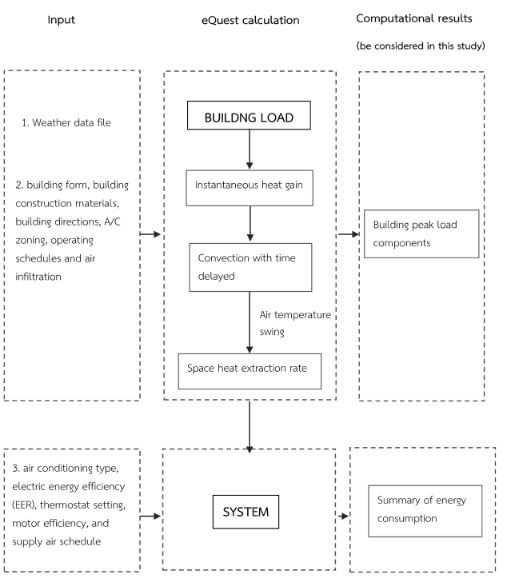Simulation Study of Applying Thermal Insulation in the Condominium Rooms to Reduce Cooling Energy
DOI:
https://doi.org/10.56261/built.v11.167857Keywords:
Insulation, Energy efficiency, Space cooling, Energy savings, BangkokAbstract
e purpose of this research is to evaluate the effect of insulation on the reduction of air conditioning energy used in the condominium room. The base case models were built in the eQuest 3.65 energy simulation program, which will calculate the baseline energy consumption using the Bangkok meteorological data. Residential room plan in this study was adopted from previous research, which had surveyed data on room types in condominiums in Bangkok. This research created a simulated model of a 33 m2 room located at different positions in the condominium. The total of 6 positions included the room on the left, right and center of the building that located on the top floor and the middle floor. These rooms were different in the area of interior wall, exterior wall and roof. The 75- and 150-mm thick insulation were added to the existing wall and ceiling to evaluate the reduction of air conditioning energy. The results showed that insulation reduced cooling energy by 1.9-21.3% compared to the base case. Installation of a 75-mm thick insulation on the existing ceiling of the room on top floor showed the shortest payback period of 4.4-5.5 years. For rooms on the middle floor, installation of 75- mm thick insulation on the wall of the room on the right of the building facing to north and west was also showed the simple payback period within 5 years.
Downloads
References
Energy Policy and Planning office [EPPO]. (2015, January 31). Policy and planning. Retrieved from http://www.eppo. go.th.
Energy Policy and Planning Office [EPPO]. (2018, January 31). Thailand energy statistics. Retrieved from http://www. eppo.go.th.
Hancharoen, K., & Chotikaprakhan, S. (2016). The study on the thermal conductivity of thermal insulation produced from core and pore of pineapple. Proceedings of 51st Kasetsart University Annual Conference: Science, Natural Resources and Environment (p. 7). Bangkok, Thailand: Kasetsart University.
Hirsch & Associates. (2009). DOE 2.2 Building energy use and cost analysis program: Volume 4 Library and Reports. California: Lawrence Berkeley National Laboratory.
Jareemit, D., & Inprom, N. (2015). Review article: Significant parameters in building energy simulation. Journal of Architectural Research and Studies, 12(1), 1-14.
King Mongkut’s Institute of Technology Ladkrabang. (2013).Price lists of building renovation. Bangkok: King Mongkut’s Institute of Technology Ladkrabang.
Koonprueksee, P. (2013). A study of program and design of upper-class condominium projects in inner Bangkok. (Master thesis). Faculty of Architecture and Planning, Thammasat University, Pathumthani, Thailand.
Puthipiroj, P. (2011). Installation of insulation made of agricultural waste in the concrete slabs. Najua, 389-401.
Siam Cement Group. (2016). SCG insulation material: STAY COOL. Retrieved from http://www.scgbuildingmaterials.com.
Thai Green Building Institute [TGBI]. (2018). TREEs. Retrieved from http://www.tgbi.or.th/.
The U.S. Green Building Council [USGBC]. (2017). LEED. Retrieved from https://new.usgbc.org/leed.
Woraput, K., Kamhangrittirong, P., Surit, S., Hancharoen, K., & Saimo, T. (2016). Wall plates from corncobs. Naresuan research conference 12 (pp. 511-520). Phisanulok: Naresuan University

Downloads
Published
How to Cite
Issue
Section
License

This work is licensed under a Creative Commons Attribution-NonCommercial-NoDerivatives 4.0 International License.











